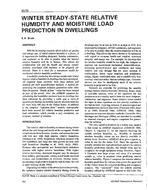Many applications of solar energy demand only low temperature water and are, therefore, quite compatible with techniques for collecting solar energy such as the use of flat-plate collectors, solar ponds, pipes, and the like. Space heating of buildings, domestic hot water heating, swimming pool heating and crop drying are examples, of this type of low temperature application. In other uses it is sometimes necessary to exceed the performance of the flat-plate collector. This may be due to a threshold temperature required for a process, or it may be to decrease the cost of process equipment by improving over-all system efficiency. An important example of each is the absorption refrigerator and electricity production by photovoltaic cells. Absorption refrigeration systems do not work well at generator temperatures below 190 F (88°C), and flat-plate collectors are normally inefficient above 160 to 170 F (71 to 77°C). The temperature of hot ‘water supplied to the generator should be preferably, above 200 F (93°C) and in many cases 225 F (109°C) for operation at rated load. In this temperature region, the linear Fresnel lens collector is considerably more effective than a flat-plate collector. Photovoltaics convert solar energy into electric energy in proportion to the incident solar energy. If sunlight impinging on the photovoltaic device is sufficiently concentrated, electric power output can be increased more than a hundredfold. Concentration of sunlight, then, provides a significant cost reduction tool with which to work. Although the concentrating collector was not designed for this use, it could be easily adapted to photovoltaic applications. Another advantage of concentrating collectors over flat-plate collectors is the smaller absorber that is employed. The absorber is usually a length of tubing, round or flattened, with fittings attached to each end. Since the absorber is smaller, it is much more practical to consider the use of expensive material or a selective coating such as black chrome. In addition, quick heat recovery is accomplished due to the small thermal inertia of the absorber plate. Temperature transients are therefore minimized and operating temperatures are attainedquite rapidly during startup.
Product Details
- Published:
- 1976
- Number of Pages:
- 10
- File Size:
- 1 file , 870 KB
- Product Code(s):
- D-SE-76-01-3
- Note:
- This product is unavailable in Russia, Belarus


